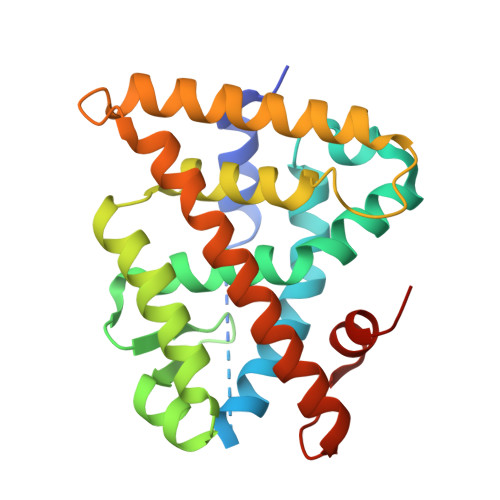Modulating retinoid X receptor with a series of (E)-3-[4-hydroxy-3-(3-alkoxy-5,5,8,8-tetramethyl-5,6,7,8-tetrahydronaphthalen-2-yl)phenyl]acrylic acids and their 4-alkoxy isomers.
Perez Santin, E., Germain, P., Quillard, F., Khanwalkar, H., Rodriguez-Barrios, F., Gronemeyer, H., de Lera, A.R., Bourguet, W.(2009) J Med Chem 52: 3150-3158
- PubMed: 19408900
- DOI: https://doi.org/10.1021/jm900096q
- Primary Citation of Related Structures:
3FUG - PubMed Abstract:
Rexinoids are ligands for the retinoid X receptor (RXR) that have great promise for both the prevention and treatment of cancer and metabolic diseases. In this regard, synthetic, functional, and structural investigations into the structure-activity relationships of derivatives of the potent RXR agonist (E)-3-[3-(3,5,5,8,8-pentamethyl-5,6,7,8-tetrahydronaphthalen-2-yl)-4-hydroxyphenyl]acrylic acid (CD3254, 9) have been conducted. We recently reported on the characterization of a series of C3'-substituted alkyl ether analogues of 9 (10a-f), which display activities ranging from partial agonists to pure antagonists. The importance of the position of the alkoxy side chain for ligand activity has been further explored with the synthesis of C4'-substituted analogues (11a-f). Here we describe the synthesis of compounds 11a-f, which appear functionally different from their isomeric counterparts, as judged from transactivation assays and fluorescence anisotropy experiments. We also report on the 2.0 A resolution structure of RXR in complex with the parent compound 9, which helps understanding of the impact of the alkyl side chain location on ligand activity.
- Departamento de Química Orgánica, Facultad de Química, Universidade de Vigo, 36310 Vigo, Spain.
Organizational Affiliation:


















